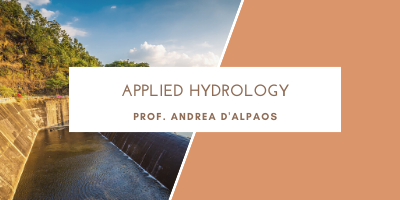Applied Hydrology

Period: Second semester
Aim of the course:
- describe various hydrologic processes and the interrelationships among them;
- describe methods of analysis of components of the hydrologic cycle;
- develop analytical tools to address hydrologic problems and problem-solving skills to such a degree that recognizes the key steps involved;
- relate to different measurement and modeling techniques for hydrologic variables and understand the inherent variability and uncertainty in those parameters.
Course units contents:
This course deals with surface water hydrology, and in particular with hydrologic processes (3.0 CFU), analysis (2.0 CFU), and design (1.0 CFU):
1) Introduction. Hydrologic cycle. Hydrologic processes. 2) Precipitation. Evaporation and plant transpiration.
Infiltration and soil processes. Rainfall excess. 3) Surface hydrology: runoff and streamflow. Open channel flow. Hydrologic response and IUH. 4) Subsurface hydrology. 5) Probability and statistics in hydrology. Return Period. Frequency analysis, risk assessment in hydrologic design. 6) Subsurface hydrology: saturated flow. Porous formations. Well hydraulics. 7) Floods: hydrologic and hydraulic design.
Based calculations within various hydrologic procedures as required for addressing surface water hydrology issues will also be covered.
Planned learning activities and teaching methods:
Learning activities and teaching methods will include:
• Lectures on theoretical aspects and their practical applications, exercises.
• Distribution of software for the study of specific hydrological problems.
• In-depth classroom exploration of topics through practical examples, later collected in an "exercise notebook".
Innovative teaching:
• Problem-based learning: students will tackle real hydrological problems.
• Case studies: analysis of specific hydrological situations.
• Simulations: use of software to model hydrological scenarios.
• Teamwork: group projects on course topics.
Direct experiences:
• Practical exercises in the classroom;
• Learning and use of specific software for studying hydrological problems.
• Compilation of an "exercise notebook" with practical examples explored in class.
• Use of educational technologies:
Online platforms for sharing materials and collaboration.
• Digital tools for simulations and interactive visualizations.
This approach aims to provide a thorough understanding of both theoretical and practical aspects of the subject, promoting active learning and the development of applied skills in the field of hydrology.
Teaching methods may be adapted to respond to specific student needs, provided that such needs are communicated to the instructor through the established institutional procedures.
In addition to contacting the course instructor, students with disabilities, Specific Learning Disorders (SLD), Special Educational Needs (SEN), and other health conditions can reach out to the Student Services Office - Inclusion Unit to receive more information about opportunities to access teaching with specific support and tools.
At the end of the course, students will be invited to complete a questionnaire to provide suggestions and observations useful for improving future editions.
The use of artificial intelligence tools is permitted for preparing reports related to the exercises; however, any such use must be explicitly declared.
